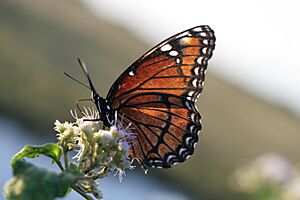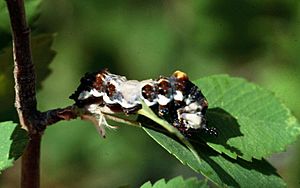Viceroy (butterfly) facts for kids
Quick facts for kids Viceroy |
|
|---|---|
 |
|
| Scientific classification | |
| Kingdom: | |
| Phylum: | |
| Class: | |
| Order: | |
| Superfamily: | |
| (unranked): | |
| Family: | |
| Genus: |
Limenitis
|
| Species: |
L. archippus
|
| Binomial name | |
| Limenitis archippus (Cramer, 1776)
|
|
The Viceroy (Limenitis archippus) is a beautiful type of butterfly found across North America. It belongs to a group of butterflies called Nymphalidae, also known as brush-footed butterflies.
Contents
What Does the Viceroy Butterfly Look Like?
The Viceroy butterfly has bright orange wings with black lines, like veins. The edges of its wings are also black. A special black band crosses its bottom wings (hind wings). This band can be hard to see or even missing in butterflies from the southwestern United States.
In Florida, Viceroys are a darker reddish-brown color instead of orange. Their wings can spread out from about 6.6 to 7.6 centimeters (2.6 to 3 inches) wide.
Clever Disguise: Mimicry
Viceroy butterflies are very clever! They use a trick called mimicry. This means they look like other animals to protect themselves.
The orange Viceroys look a lot like the Monarch (Danaus plexippus). The reddish-brown Viceroys look like the Queen (Danaus gilippus) and the Soldier (Danaus eresimus) butterflies.
Why do they do this? Monarchs, Queens, and Soldiers taste very bad to predators like birds. By looking similar, the Viceroy also warns predators to stay away, even though the Viceroy itself is also bitter-tasting. This shared warning system is called Müllerian mimicry. It's like they all wear the same "Do Not Eat Me!" sign.
Where and When Do They Fly?
Viceroy butterflies live in many wet, open places. You can find them near water, in wet meadows, and in freshwater marshes.
Adult Viceroys usually fly around in the late morning and early afternoon.
Their flight season changes depending on where they live:
- In northern Canada, they fly from June to July.
- In southern Canada and the northern United States, you can see them from May to October.
- In southern Florida, they fly all year long!
- In the southwestern United States, they are seen from April to November.
Life Cycle of the Viceroy Butterfly
The female Viceroy butterfly lays her eggs one by one. She places each egg at the very tip of a leaf from a "host plant." A host plant is the specific plant that the caterpillar will eat.
The eggs start as pale green or yellow and later turn gray.
The Caterpillar Stage
The Viceroy caterpillar feeds at night. It has an amazing disguise: it looks like a bird dropping! This helps it hide from hungry birds. The caterpillar is white, brown, black, and olive green. It has two greenish bumps on its body (called the thorax) and two small spines near its head.
Caterpillars eat trees from the willow family, like willows (Salix) and poplars or cottonwoods (Populus). These plants contain a chemical called salicylic acid. The caterpillars store this acid in their bodies, which makes them taste bitter and upsets the stomachs of animals that try to eat them.
The Chrysalis Stage
After growing, the caterpillar turns into a chrysalis. The chrysalis also looks like a bird dropping! It is white, brown, and black, with a large brownish bump on its back (called the abdomen).
During winter, the caterpillar will hibernate (sleep) inside a special shelter made from a leaf.
The number of times a Viceroy lays eggs in a year depends on the climate:
- In northern Canada, they lay one group of eggs per year.
- In southern Canada and the United States, they can lay 2 to 3 more groups of eggs.
Images for kids
See also
 In Spanish: Mariposa virrey para niños
In Spanish: Mariposa virrey para niños






